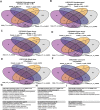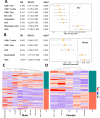This is a preprint.
Sex differences in viral entry protein expression and host transcript responses to SARS-CoV-2
- PMID: 33173861
- PMCID: PMC7654875
- DOI: 10.21203/rs.3.rs-100914/v2
Sex differences in viral entry protein expression and host transcript responses to SARS-CoV-2
Abstract
Epidemiological studies suggest that men exhibit a higher mortality rate to COVID-19 than women, yet the underlying biology is largely unknown. Here, we seek to delineate sex differences in the gene expression of viral entry proteins ACE2 and TMPRSS2, and host transcriptional responses to SARS-CoV-2 through large-scale analysis of genomic and clinical data. We first compiled 220,000 human gene expression profiles from three databases and completed the meta-information through machine learning and manual annotation. Large scale analysis of these profiles indicated that male samples show higher expression levels of ACE2 and TMPRSS2 than female samples, especially in the older group (>60 years) and in the kidney. Subsequent analysis of 6,031 COVID-19 patients at Mount Sinai Health System revealed that men have significantly higher creatinine levels, an indicator of impaired kidney function. Further analysis of 782 COVID-19 patient gene expression profiles taken from upper airway and blood suggested men and women present distinct expression changes. Computational deconvolution analysis of these profiles revealed male COVID-19 patients have enriched kidney-specific mesangial cells in blood compared to healthy patients. Together, this study suggests biological differences in the kidney between sexes may contribute to sex disparity in COVID-19.
Keywords: COVID-19; sex difference.
Conflict of interest statement
Competing interests The authors declare no competing interests.
Figures





References
-
- The Sex, Gender and COVID-19 Project | Global Health 50/50. https://globalhealth5050.org/the-sex-gender-and-covid-19-project/.
-
- COVID-19 Provisional Counts - Weekly Updates by Select Demographic and Geographic Characteristics. https://www.cdc.gov/nchs/nvss/vsrr/covid_weekly/index.htm (2020).
Publication types
Grants and funding
LinkOut - more resources
Full Text Sources
Miscellaneous

